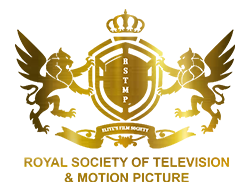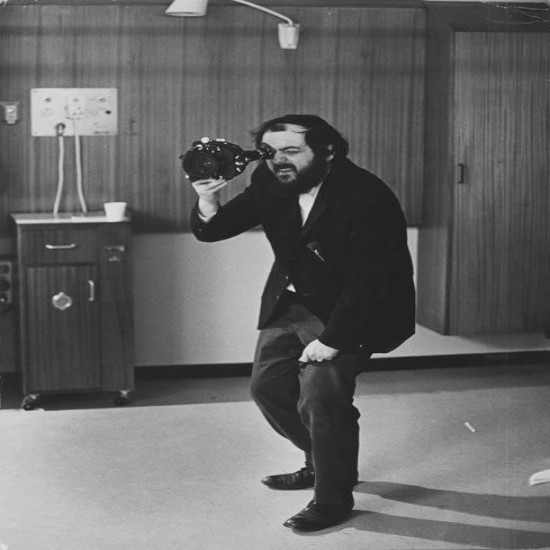
Stanley Kubrick & The Birth of Visual Poetry
Written by Shailik Bhaumik
The power of imagination makes us infinite – John Muir
[dropcap]S[/dropcap]ecretive, reclusive, strange, mysterious or cold whatever they say about Stanley Kubrick doesn’t fade the distinguished mark he left in the history of cinema through his works. Stanley Kubrick was far from a one-dimensional director. It’s true that the 13 feature-length films he made over 50 years of his film career present a disenchanted, sardonic and generally pessimistic view of humanity but what elevates Kubrick one of the greatest storytellers of all time is his challenging, thought-provoking body of work that stands in comparison with any of the giants of world cinema.
His films, which frequently mix incisive political messages with disturbing character relationships and iconic horror imagery, are simultaneously artful and raw. In perhaps his best-known film, The Shining, his uncanny, labyrinthine and geometric framing of the film’s hotel setting transform inanimate objects like tricycles and corridors into pseudo-characters in themselves, capable of conveying horror and unease even without explicit violence.
In his Vietnam War indictment Full Metal Jacket, Kubrick blurs the line between military brutality and full-blown abuse, masculinity and femininity, violence and sexuality, in ways no other filmmaker could. Indeed, his unique blending of beauty and ugliness, politics and psychology, composure and unease, have marked Kubrick’s cinema even since his earliest projects, such as Fear and Desire (1953), Killer’s Kiss (1955), The Killing (1956).
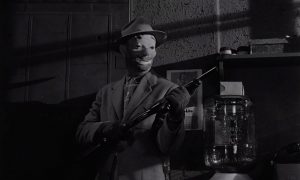
Kubrick was raised in the Bronx, New York City, and attended William Howard Taft High School from 1941 to 1945. Although he only received average grades, Kubrick displayed a keen interest in literature, photography, and film from a young age, and taught himself all aspects of film production and directing after graduating from high school. After working as a photographer for Look magazine in the late 1940s and early 1950s, he began making short films on a shoestring budget, and made his first major Hollywood film, The Killing, for United Artists in 1956. This was followed by two collaborations with Kirk Douglas, the war picture Paths of Glory (1957) and the historical epic Spartacus (1960). His reputation as a filmmaker in Hollywood grew, and he was approached by Marlon Brando to film what would become One-Eyed Jacks (1961), though Brando eventually decided to direct it himself.

Creative differences arising from his work with Douglas and the film studios, a dislike of Hollywood, and a growing concern about crime in America prompted Kubrick to move to the United Kingdom in 1961, where he spent most of the remainder of his life and career. His home at Childwickbury Manor in Hertfordshire, which he shared with his wife Christiane, became his workplace, where he did his writing, research, editing, and management of production details. This allowed him to have almost complete artistic control over his films, but with the rare advantage of having financial support from major Hollywood studios. His first British productions were two films with Peter Sellers, Lolita(1962) and Dr. Strangelove (1964).

A demanding perfectionist, Kubrick assumed control over most aspects of the filmmaking process, from direction and writing to editing, and took painstaking care with researching his films and staging scenes, working in close coordination with his actors and other collaborators. He often asked for several dozen retakes of the same scene in a movie, which resulted in many conflicts with his casts. Despite the resulting notoriety among actors, many of Kubrick’s films broke new ground in cinematography. The scientific realism and innovative special effects of 2001: A Space Odyssey (1968) were without precedent in the history of cinema, and the film earned him his only personal Oscar, for Best Visual Effects. Steven Spielberg has referred to the film as his generation’s “big bang”, and it is regarded as one of the greatest films ever made. For the 18th-century period film Barry Lyndon(1975), Kubrick obtained lenses developed by Zeiss for NASA, to film scenes under natural candlelight. With The Shining (1980), he became one of the first directors to make use of a Steadicam for stabilized and fluid tracking shots. While many of Kubrick’s films were controversial and initially received mixed reviews upon release—particularly A Clockwork Orange (1971), which Kubrick pulled from circulation in the UK following a mass media frenzy—most were nominated for Oscars, Golden Globes, or BAFTA Awards, and underwent critical reevaluations. His last film, Eyes Wide Shut, was completed shortly before his death in 1999 at the age of 70.
Kubrick’s Legendary Film Techniques
Stanley Kubrick is noted for being a demanding perfectionist, using painstaking care with scene staging, camera-work and coordinating extremely closely both with his actors and his behind scenes collaborators. Kubrick’s great obsession was: the relationship between the artificial and the natural, the constrained and the unleashed, the civilized and the base, the man and the machine.
People misunderstand Kubrick, based on thinking about only one film, or one scene from one film, believing he was anti-technology or anti-nature. In fact, his films, when taken as a whole, are less moralistic than journalistic: he’s reporting on human nature, and he doesn’t believe it’s malleable.
Characters as caricatures:In his films, many of the characters’ traits are highly exaggerated. Examples: Dr. Strangelove, Clockwork Orange (Alex himself, Dim, Deltoid); The Shining (Jack, Lloyd); Lolita (Humbert Humbert, Clare Quilty, Lolita).

Women portrayed as objects:
Women are heavily objectified in many of Kubrick’s films. Examples? Some of them (A Clockwork Orange, Lolita, and Eyes Wide Shut) are more obvious, but some less so. For example: in Dr. Strangelove the only woman who appears in the film is General “Buck” Turgidson’s secretary Miss Scott, with whom he’s having an affair. Her entire scene is done with her wearing spotted lingerie while briefing Turgidson on a military matter.
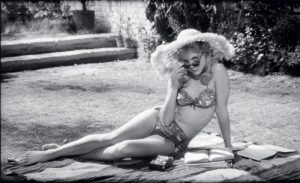
Unusual use of zoom:
The slow zoom-out comprising the first shot of A Clockwork Orange may be one of the most famous zoom shots in the history of cinema. Kubrick also uses dramatic zooming in many of his other films. Usually it’s unusually fast or unusually slow and he loved close-ups of human faces, caught in extremely primal emotive states.
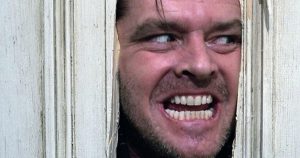
Long tracking shots:
Famous tracking shots include those inside the hotel in The Shining following Danny on his bike as he rides through the halls, a very long tracking take moving through the trenches in Paths of Glory, and multiple tracking shots in Clockwork Orange, 2001, and Barry Lyndon.
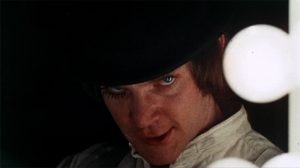
Wide-angle lenses:
Kubrick employs extreme wide-angle lenses in almost all of his films. You can see the distortion at the bounds of the image in tracking shots that use a wide-angle, especially when the camera turns during a tracking shot. He also uses the wide angle lens up close to actors’ faces in some situations to provide a sense of urgency or pathos.
Extremely long takes:
Most of Kubrick’s films have shots lasting three or four minutes, or perhaps longer. One example of an unusually long take is the scene in Clockwork Orange in which Alex is checked into the Ludovico building. We see the entire check-in, from beginning to end — something that many filmmakers would simply skip over.
Wide shots:
In addition to using a wide-angle lens, Kubrick often eschews with close-ups and two-shots in favor of three-shots or even wider shots… making many of the characters blend in more with the scenery. He was obsessed with regimented images (a better term than “symmetrical”), such as the military marches in “Barry Lyndon,” the marines marching in “Full Metal Jacket” and the Droogs strolling in formation in “A Clockwork Orange.”
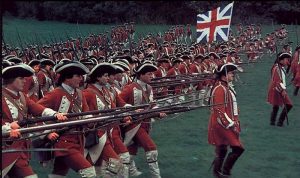
Although his career extended over nearly half a century, Kubrick made only 13 feature films. Nevertheless, he is remembered as a master filmmaker and supreme visual stylist. Arguably, he is even more admired by other filmmakers than he is by critics and cineastes. The releases of his films were events. Kubrick was a perfectionist whose passionate involvement with his art meant that he could often be very difficult to work with (occasionally harsh or cruel to his collaborators, though also very warm). For all of the planning that went into his projects, he often discovered the structure of his films as he made them, and he was extremely open to experimentation and the ideas of others. Kubrick’s meticulous involvement with seemingly every detail that went into his films earned him a reputation as a control freak, but it also guaranteed that his signature was indelibly imprinted on every film that he made.

Shailik Bhaumik is an award-winning filmmaker and entrepreneur. Known for his feature film “Dasein”, Shailik is the founder and Chairman of Human Lab Corporation, a Multinational Film Company whose mission it is to help Independent Filmmakers survive and thrive in this highly competitive industry. Shailik oversees worldwide operations including production, distribution, and marketing for HLC’s live-action films, as well as films released under the HLC banner.
